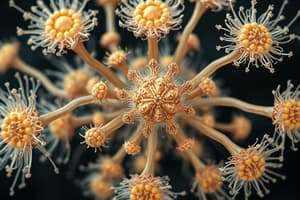Podcast
Questions and Answers
What is the primary phase of the Diplontic Life Cycle?
What is the primary phase of the Diplontic Life Cycle?
- Gametic phase
- Diploid phase (correct)
- Zygotic phase
- Haploid phase
What feature distinguishes dinoflagellates from other marine protists?
What feature distinguishes dinoflagellates from other marine protists?
- Presence of a single flagellum
- Absence of pigments
- Cellulose plates in their cell wall (correct)
- Lack of bioluminescence
Which pigments are primarily responsible for the coloration in dinoflagellates?
Which pigments are primarily responsible for the coloration in dinoflagellates?
- Melanin and Chlorophyll 'b'
- Phycobilins only
- Carotenoids and Anthocyanins
- Chlorophyll 'a' and Xanthophylls (correct)
What name is given to the phenomenon caused by the rapid multiplication of red dinoflagellates?
What name is given to the phenomenon caused by the rapid multiplication of red dinoflagellates?
What distinguishes diatoms from other forms of algae?
What distinguishes diatoms from other forms of algae?
What term describes the large accumulation of diatom cell wall deposits?
What term describes the large accumulation of diatom cell wall deposits?
Which of the following species is known for secreting toxins that can affect humans?
Which of the following species is known for secreting toxins that can affect humans?
What is the significance of histone protein in the chromosomes of dinoflagellates?
What is the significance of histone protein in the chromosomes of dinoflagellates?
Which of the following organisms are included in the Kingdom Protista?
Which of the following organisms are included in the Kingdom Protista?
What type of nutrition is described as ingesting food before digestion in protists?
What type of nutrition is described as ingesting food before digestion in protists?
Which reproductive process in protists involves the fusion of two haploid gametes?
Which reproductive process in protists involves the fusion of two haploid gametes?
Which type of life cycle is characterized by the formation of gametes by mitosis?
Which type of life cycle is characterized by the formation of gametes by mitosis?
What type of reproduction involves the formation of spores in specific structures?
What type of reproduction involves the formation of spores in specific structures?
What type of nutrition do organisms like Euglena exhibit?
What type of nutrition do organisms like Euglena exhibit?
Which of the following types of gamete fusion is characterized by dissimilar size or structure?
Which of the following types of gamete fusion is characterized by dissimilar size or structure?
Which kingdom serves as a link between plants, animals, and fungi due to its characteristics?
Which kingdom serves as a link between plants, animals, and fungi due to its characteristics?
What is the primary environment where members of the Kingdom Protista are found?
What is the primary environment where members of the Kingdom Protista are found?
Which mode of nutrition absorbs nutrients directly from dead organic matter?
Which mode of nutrition absorbs nutrients directly from dead organic matter?
Flashcards are hidden until you start studying
Study Notes
Kingdom Protista
- Comprises all unicellular eukaryotes primarily found in aquatic environments.
- Key groups within Protista include dinoflagellates, chrysophytes (diatoms and desmids), euglenoids, slime moulds, and protozoa.
Main Characteristics of Protista
- All protists are unicellular and possess a complex eukaryotic cellular structure.
- Show traits of plants, animals, and fungi, bridging the gaps between these kingdoms.
- Feature a well-defined nucleus and membrane-bound organelles.
Nutrition
- Holophytic or Photosynthetic: Capable of producing own food through photosynthesis.
- Holozoic: Ingestion followed by digestion, resembling animal nutrition.
- Osmotrophic or Absorptive: Digestion occurs before ingestion, can be parasitic (living hosts) or saprophytic (dead organic matter).
- Mixotrophic: Exhibit more than one nutritional mode, e.g., Euglena.
Movement
- Various motility strategies, including flagella (dinoflagellates, euglenoids, protozoans) and cilia (protozoans).
Reproduction
- Both asexual and sexual reproduction mechanisms are present.
- Asexual Reproduction:
- Binary fission: Division of one cell into two daughter cells.
- Spore formation: Creation of spores in structures called sporangia, that develop into new protists.
- Sexual Reproduction:
- Syngamy involves two haploid gametes fusing to form a diploid zygote, with three variations:
- Isogamy: Morphologically similar gametes fuse.
- Anisogamy: Morphologically dissimilar gametes fuse.
- Oogamy: Male gamete is small and motile, while the larger female gamete is immobile.
- Syngamy involves two haploid gametes fusing to form a diploid zygote, with three variations:
Life Cycle
- Haplontic Life Cycle: Gametes formed by mitosis are haploid and participate in sexual reproduction.
- Diplontic Life Cycle: Involves meiosis in a diploid cell, leading to haploid gametes that fuse to create a diploid zygote.
Dinoflagellates
- Characterized by two flagella, primarily marine and photosynthetic.
- Exhibit color variation due to pigments like chlorophyll "a", "c", and xanthophylls; serve as natural indicators of ecosystems.
- Known as "armored algae" due to rigid cell walls composed of cellulose plates.
- Display bioluminescence and sometimes cause phenomena like "red tide" through rapid population growth.
- Some species can produce neurotoxins harmful to marine life and humans via the food chain.
Chrysophytes
- Include diatoms and golden algae (desmids), found in freshwater and marine ecosystems.
- Known as "pearls of oceans" due to their unique structures and ecological importance.
Diatoms Structure
- Exhibit a variety of shapes like circular, rectangular, triangular, elongated, and boat-shaped.
- Cell walls consist of two overlapping silica-reinforced shells, making them resilient and forming diatomaceous earth deposits over geological time.
Studying That Suits You
Use AI to generate personalized quizzes and flashcards to suit your learning preferences.




